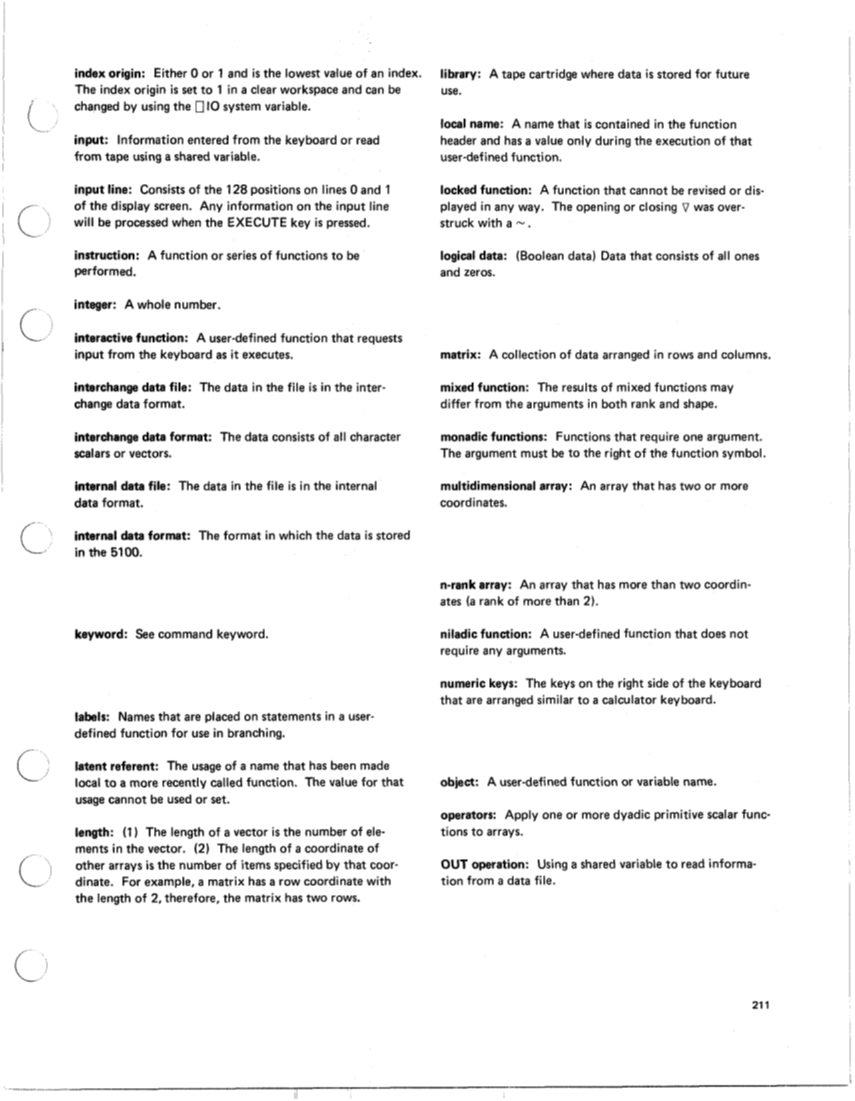data file: A file on tape (file type 01, 02, or 08) where
data was stored using a shared variable.
defective record: A 51 2-byte block of storage on tape that
cannot be read.
devicdfile number: Specifies the tape unit and file to be
used when doing tape input or output operations.
dual-language machine: A 5100 that can execute either
APL or BASIC statements.
dyadic functions: Functions that require two arguments
(a right and a left argument).
editing: Modifying an instruction or statement that already
exists.
element: The single item of data in an array.
empty array: A variable that has a zero in its shape vector.
The array has no (zero) elements.
execute: To press the EXECUTE key to process data on
the input line.
execution: The processing of data.
execution mode: The mode that is operative when state-
ments or functions are executed. Contrast with function
definition mode.
explicit result: The result of a function that can be used in
further calculations. The function must contain a result
variable if it is to have an explicit result.
file: A specified amount of storage on tape. The tape is
formatted into files by using the )MARK command.
file ID: The name of a file on tape. If the file contains a
stored workspace, the file ID is the same as the stored
workspace ID.
file number: The files on tape are sequentially numbered
starting from one.
file type: Identifies the type of data stored in a file.
function body: Consists of the statements within a user-
defined function. These statements determine the opera-
tion(s) performed by the function.
function definition: Defining a new function (a user-
defined function) to solve a problem.
function definition mode: The mode that is used when
defining or editing user-defined functions. The V symbol
is used to change the mode of operation. Contrast with
execution mode.
function header: Defines the function name, number of
arguments, local names, and whether or not the function
will have an explicit result.
general interchange data file: The data in the file is in the
general interchange format.
general interchange data format: The data consists of all
character scalars or vectors.
global names: The value associated with these names can
be used within or outside of a user-defined function unless
the name has been made local to a user-defined function
that is executing, suspended, or pendent. Contrast with
local names.
identity element: The value that generates a result equal
to the other argument.
IN operation: Using a shared variable to write information
into a data file.
index entry [I] : (1 ) A value or values enclosed in brackets
that select(s1 certain elements from an array. (2) A value
enclosed in brackets that determines the coordinate of an
array to be acted on by a primitive mixed function.
21 0
data was stored using a shared variable.
defective record: A 51 2-byte block of storage on tape that
cannot be read.
devicdfile number: Specifies the tape unit and file to be
used when doing tape input or output operations.
dual-language machine: A 5100 that can execute either
APL or BASIC statements.
dyadic functions: Functions that require two arguments
(a right and a left argument).
editing: Modifying an instruction or statement that already
exists.
element: The single item of data in an array.
empty array: A variable that has a zero in its shape vector.
The array has no (zero) elements.
execute: To press the EXECUTE key to process data on
the input line.
execution: The processing of data.
execution mode: The mode that is operative when state-
ments or functions are executed. Contrast with function
definition mode.
explicit result: The result of a function that can be used in
further calculations. The function must contain a result
variable if it is to have an explicit result.
file: A specified amount of storage on tape. The tape is
formatted into files by using the )MARK command.
file ID: The name of a file on tape. If the file contains a
stored workspace, the file ID is the same as the stored
workspace ID.
file number: The files on tape are sequentially numbered
starting from one.
file type: Identifies the type of data stored in a file.
function body: Consists of the statements within a user-
defined function. These statements determine the opera-
tion(s) performed by the function.
function definition: Defining a new function (a user-
defined function) to solve a problem.
function definition mode: The mode that is used when
defining or editing user-defined functions. The V symbol
is used to change the mode of operation. Contrast with
execution mode.
function header: Defines the function name, number of
arguments, local names, and whether or not the function
will have an explicit result.
general interchange data file: The data in the file is in the
general interchange format.
general interchange data format: The data consists of all
character scalars or vectors.
global names: The value associated with these names can
be used within or outside of a user-defined function unless
the name has been made local to a user-defined function
that is executing, suspended, or pendent. Contrast with
local names.
identity element: The value that generates a result equal
to the other argument.
IN operation: Using a shared variable to write information
into a data file.
index entry [I] : (1 ) A value or values enclosed in brackets
that select(s1 certain elements from an array. (2) A value
enclosed in brackets that determines the coordinate of an
array to be acted on by a primitive mixed function.
21 0









































































































































































































































